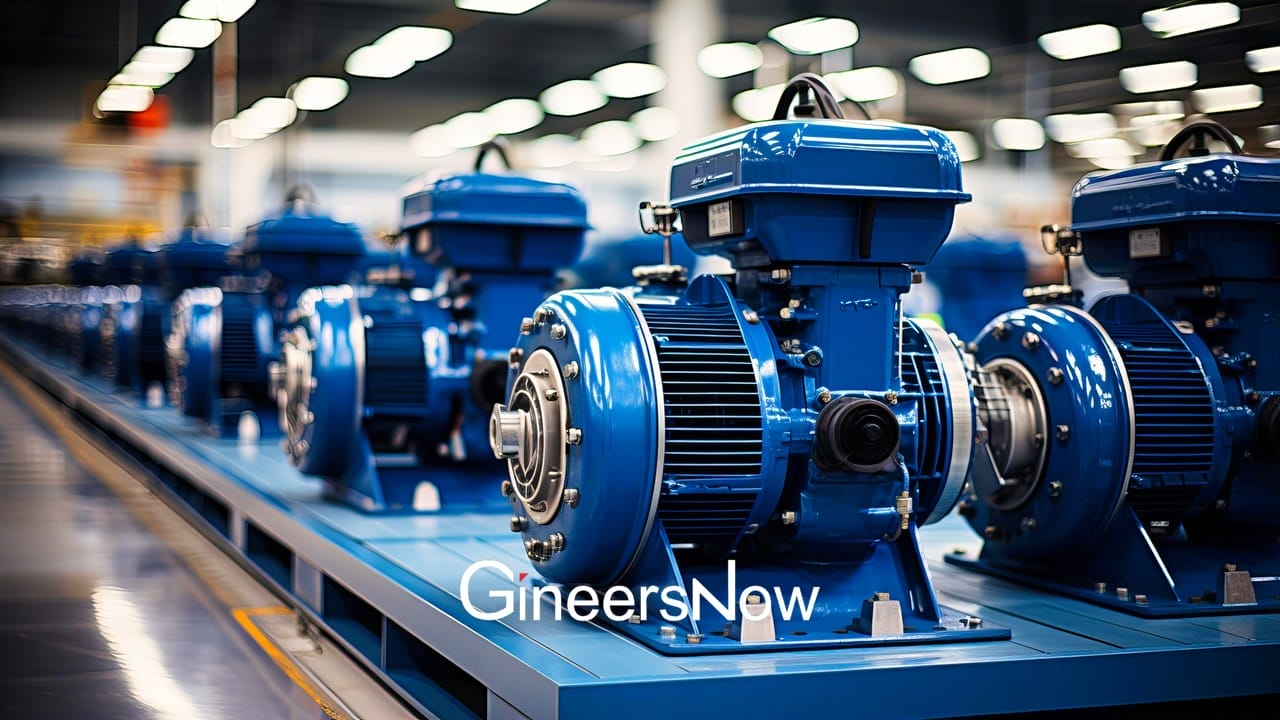Two common types stand out in the world of pumping systems: centrifugal and rotary pumps in the Philippines. Understanding the differences between these two types of pumps can help industries and individuals decide when to choose the right pump for their specific needs. In this blog post, we will explore the four major differences between rotary pumps and centrifugal pumps.
What are Rotary Pumps?
Rotary pumps are a type of positive displacement pump that operates by trapping fluid between rotating components within a casing to move it from the inlet to the outlet. These pumps are commonly used in various industries and applications, including oil and gas, chemical processing, and water treatment. In the Philippines, rotary pumps are widely used for irrigation systems and water distribution networks in the agricultural sector.
The working principle of rotary pumps involves the rotation of a mechanism, such as gears, lobes, or screws, inside a housing to create a continuous flow of fluid. As the rotating components move, they create pockets of low pressure that draw the fluid into the pump and then force it out through the outlet. This efficient fluid transfer method makes rotary pumps ideal for handling viscous liquids, slurries, and high-pressure applications in the Philippines and worldwide.
What are Centrifugal Pumps?
Centrifugal pumps in the Philippines are mechanical devices designed to move fluid through the conversion of rotational kinetic energy into hydrodynamic energy. These pumps are widely used in various industries for fluid transportation, including water supply, wastewater treatment, agriculture, and oil refining processes. The key components of centrifugal pumps include an impeller, casing, and inlet and outlet ports.
Centrifugal pumps utilize the rotating impeller to create a centrifugal force that pushes the fluid toward the outer edges of the impeller blades. As the fluid moves through the impeller, it gains kinetic energy and is discharged through the pump’s outlet at a higher pressure than the inlet. This continuous fluid flow creates a centrifugal force that propels the liquid through the system. Centrifugal pumps in the Philippines. Ensure efficient fluid transfer, essential for various industrial and commercial applications.

Where Can You Buy Centrifugal and Rotary Pumps in the Philippines?
If you want to purchase centrifugal and rotary pumps in the Philippines, online platforms such as Lazada and Shopee offer a convenient and wide selection of these products. These e-commerce websites provide a range of options for buyers looking for reliable and efficient pumps for various applications. Whether you need centrifugal or rotary pumps, shopping online on Lazada and Shopee can help you find the right product to meet your needs.
What are the Major Differences Between Centrifugal and Rotary Pumps in the Philippines?
Centrifugal and rotary pumps in the Philippines play crucial roles in various industries. These two types of pumps have distinct design, operation, and application differences. Centrifugal pumps utilize centrifugal force to move fluid through the pump, while rotary pumps use rotating mechanisms to create suction and displace the fluid.
Centrifugal pumps are commonly used for high-flow, low-pressure applications, such as water circulation in buildings, irrigation, and cooling systems. Rotary pumps, on the other hand, are ideal for high-pressure, low-flow applications, such as in oil refineries, chemical processing plants, and hydraulic systems.
Understanding the major differences between centrifugal and rotary pumps in the Philippines is essential for selecting the right pump for specific industrial needs and ensuring efficient and reliable operations.

Here are the main differences between the two:
1. Operating Principle
Centrifugal and rotary pumps are essential components in various industries in the Philippines, playing a crucial role in fluid transfer and circulation processes. Centrifugal pumps use a rotating impeller to generate centrifugal force, effectively pushing fluid through the pump and into the desired system. These pumps are commonly used in applications with high flow rates, making them ideal for industries such as water treatment, agriculture, and manufacturing in the Philippines.
On the other hand, rotary pumps in the Philippines work by trapping fluid between rotating components, providing a steady and consistent flow of liquids or gases. These pumps are known for their efficiency in handling viscous fluids. They are often utilized in industries that require precise and controlled fluid transfer, such as the food and beverage sector and pharmaceutical manufacturing. Centrifugal and rotary pumps are vital in ensuring smooth operations across various industries in the Philippines, highlighting their importance in maintaining productivity and efficiency in fluid handling processes.
2. Applications
Centrifugal pumps are widely used in the Philippines for applications requiring high flow rates and handling low-viscosity fluids. These pumps convert rotational energy into kinetic energy to create a centrifugal force that propels the fluid through the pump. Industries such as water treatment plants, agricultural irrigation systems, and HVAC systems in the Philippines benefit from the efficiency and reliability of centrifugal pumps. With their ability to handle large volumes of fluid efficiently, centrifugal pumps play a crucial role in various industrial processes nationwide.
On the other hand, rotary pumps are preferred in the Philippines for applications involving highly viscous fluids and delicate solids. These pumps operate by trapping the fluid between rotating components and the pump casing to create a steady flow. Industries such as food processing, pharmaceutical manufacturing, and chemical processing rely on rotary pumps to handle sensitive materials gently. The versatility and precision of rotary pumps make them essential equipment for ensuring smooth operations and product quality in various sectors in the Philippines.
3. Efficiency and Maintenance
Regarding centrifugal and rotary pumps in the Philippines, businesses must consider the trade-offs between efficiency and maintenance. Rotary pumps are known for their higher efficiency than centrifugal pumps, making them a popular choice for applications requiring consistent and precise fluid transfer. However, the complex internal mechanics of rotary pumps also require frequent maintenance to ensure smooth operation. This maintenance can involve regular inspections, lubrication, and replacement of parts, which may result in higher operating costs for businesses using rotary pumps in the Philippines.
On the other hand, centrifugal pumps offer a less maintenance-intensive option for businesses in the Philippines. While centrifugal pumps may have lower overall efficiency than rotary pumps, their simpler design makes them easier to maintain and less prone to mechanical issues. This can result in lower maintenance costs and greater reliability for businesses relying on centrifugal pumps in the Philippines. Ultimately, the choice between centrifugal and rotary pumps in the Philippines will depend on each business’s specific needs and priorities, weighing factors such as efficiency, maintenance requirements, and long-term cost considerations.
4. Cost and Size
When considering centrifugal and rotary pumps in the Philippines, it is important to note the differences in cost and size between the two types of pumps. Centrifugal pumps are generally more cost-effective and compact than rotary pumps. This makes centrifugal pumps a practical choice for applications where budget constraints and limited space are key considerations. Industries and businesses in the Philippines looking for efficient and affordable pumping solutions may find centrifugal pumps suitable for their operations.
On the other hand, rotary pumps are typically more expensive and larger than centrifugal pumps. While rotary pumps may have higher upfront costs and require more space for installation, they offer advantages such as higher efficiency and the ability to handle high-viscosity fluids. In certain industries in the Philippines that require precise fluid handling and are willing to invest in quality and performance, rotary pumps may be the preferred choice despite their higher cost and larger footprint.

FAQs About Centrifugal and Rotary Pumps in the Philippines
Here are the frequently asked questions about centrifugal and rotary pumps in the Philippines:
What are the main differences between centrifugal and rotary pumps?
Centrifugal pumps operate by using kinetic energy to move fluids, while rotary pumps function by rotating a mechanism that traps and transfers the liquid. Another key disparity lies in their applications, with centrifugal pumps commonly used for high-flow, low-pressure systems and rotary pumps ideal for low-flow, high-pressure scenarios. Additionally, centrifugal pumps are generally easier to maintain due to fewer moving parts than rotary pumps. Understanding these distinctions can help select the most suitable pump for specific needs in various industries across the Philippines.
How do centrifugal pumps work compared to rotary pumps?
Centrifugal pumps utilize kinetic energy to propel fluids, relying on a rotating impeller to create a flow within the pump. Conversely, rotary pumps employ a mechanism that rotates within the pump housing, effectively trapping and transferring the liquid. The operational disparity between the two pump types also extends to their efficiency levels and maintenance requirements. While centrifugal pumps are favored for high-flow, low-pressure systems due to their design simplicity, rotary pumps excel in low-flow, high-pressure applications where precision is paramount. Selecting the ideal pump type hinges on understanding these nuanced differences and matching them with specific industry demands in the dynamic landscape of the Philippines.
What are the common applications for centrifugal pumps in the Philippines?
Centrifugal pumps find wide-ranging applications in the Philippines, from water treatment plants to agricultural irrigation systems and industrial processing facilities. Their ability to handle high-flow, low-pressure scenarios makes them indispensable in numerous industries requiring efficient fluid movement. In contrast, rotary pumps showcase their prowess in low-flow, high-pressure environments prevalent in chemical processing, oil refineries, and hydraulic systems nationwide. Understanding these distinctions is crucial for selecting the most appropriate pump type tailored to specific operational requirements and performance expectations in the diverse sectors driving economic growth in the Philippines.
What are the advantages of using rotary pumps over centrifugal pumps?
When considering the advantages of utilizing rotary pumps over centrifugal pumps in various applications, one must delve into the nuances of their operational mechanisms and performance characteristics. Rotary pumps offer distinct benefits in scenarios necessitating precise fluid transfer at high pressures within industries such as chemical processing, oil refineries, and hydraulic systems across the Philippines. Their ability to maintain consistency in low-flow, high-pressure environments sets them apart from centrifugal pumps, which excel in high-flow, low-pressure systems. By comprehending these differences and aligning them with specific operational demands, industries can optimize efficiency and productivity while navigating the intricate landscape of pump selection in the dynamic Filipino market.
Are centrifugal pumps more energy-efficient than rotary pumps?
In comparing the energy efficiency of centrifugal pumps to rotary pumps, a detailed analysis is essential to grasp their distinct operational efficiencies. Centrifugal pumps, renowned for their effectiveness in high-flow, low-pressure systems due to kinetic energy utilization, present a contrasting picture to the precision-driven performance of rotary pumps in low-flow, high-pressure environments. The intricate interplay between design intricacies and fluid dynamics underscores the importance of selecting the optimal pump type tailored to specific industry demands. Delving deeper into these nuances can unlock invaluable insights for enhancing operational efficiency and productivity across diverse sectors in the Philippines’ dynamic landscape of pump applications.
How do I choose between a centrifugal and rotary pump for my specific needs in the Philippines?
When deciding between a centrifugal and rotary pump for your needs in the Philippines, consider factors beyond mere operational mechanisms. Evaluating the intricacies of fluid dynamics, system pressure requirements, and maintenance considerations is crucial. Additionally, analyzing energy efficiency metrics and anticipated performance outcomes can guide your decision-making process effectively. Opting for a centrifugal pump may be advantageous in high-flow, low-pressure applications where kinetic energy plays a vital role. In contrast, rotary pumps shine in precision-demanding, low-flow scenarios such as chemical processing or hydraulic systems. Tailoring your pump selection to align with industry demands ensures optimal functionality and long-term success in the dynamic Filipino market.
What maintenance procedures are required for centrifugal pumps in the Philippines?
To ensure optimal performance and longevity, maintenance procedures for centrifugal pumps in the Philippines encompass regular inspection of key components, such as the impeller, casing, and bearings. Additionally, preventive measures like lubrication checks and alignment assessments are essential to mitigate potential breakdowns and uphold operational efficiency. The intricate nature of centrifugal pump systems necessitates a comprehensive understanding of fluid dynamics and mechanical intricacies to execute maintenance tasks effectively. By adhering to stringent maintenance protocols tailored to specific industry demands, businesses can safeguard their centrifugal pump investments and sustain seamless operations across various sectors in the dynamic Filipino market.
Can centrifugal pumps handle abrasive materials commonly found in the Philippines?
Centrifugal pumps generally struggle with abrasive materials due to their design limitations, making them less suitable for applications involving such substances in the Philippines. The propensity of abrasive materials to cause wear and tear on the pump components can significantly impact operational efficiency and longevity. In contrast, rotary pumps exhibit greater resilience when handling abrasive fluids, thanks to their robust construction and mechanism that effectively manages such challenges. Understanding this crucial disparity is vital for industries dealing with abrasive substances in the dynamic landscape of the Filipino market, guiding them toward selecting the most appropriate pump type for optimized performance and durability.
Are there specific safety considerations when operating centrifugal pumps in the Philippines?
Safety considerations should be prioritized when operating centrifugal pumps in the Philippines to ensure optimal performance and mitigate potential risks. Factors such as pressure levels, fluid compatibility, and electrical hazards require meticulous attention to safeguard personnel and equipment. Implementing comprehensive training programs for operators, conducting regular maintenance checks, and adhering to industry standards are essential practices for safe pump operation. Additionally, establishing emergency protocols and maintaining a proactive approach to risk management can enhance workplace safety and prevent accidents in diverse industrial settings across the dynamic landscape of the Filipino market.
– What are the typical lifespan and durability of centrifugal and rotary pumps used in the Philippines?
The lifespan and durability of centrifugal and rotary pumps used in the Philippines vary based on several factors, including maintenance practices, operating conditions, and material quality. Centrifugal pumps generally exhibit a longer lifespan due to their simpler design with fewer moving parts, translating to reduced wear and tear over time. In contrast, while offering robustness in handling abrasive materials, rotary pumps may require more frequent maintenance to sustain optimal performance. Understanding these nuances is crucial for industries seeking reliable fluid transfer solutions tailored to their specific operational demands amidst the diverse sectors driving economic growth in the dynamic Filipino market.
Concluding Thoughts: Centrifugal and Rotary Pumps in the Philippines
When selecting between centrifugal and rotary pumps in the Philippines, it is crucial to weigh each type’s advantages and disadvantages based on the local market’s unique demands. Centrifugal pumps are commonly favored for their simplicity, high flow rates, and suitability for applications requiring continuous pumping of liquids with low viscosity. On the other hand, rotary pumps are known for their ability to handle viscous fluids effectively, making them ideal for industries in the Philippines that deal with thicker liquids such as oil, chemicals, and food products. Understanding the specific requirements of industries in the Philippines, such as agriculture, manufacturing, and water treatment, can help determine whether centrifugal or rotary pumps are better suited.
Furthermore, in the context of cost-effectiveness and long-term performance, the choice between centrifugal and rotary pumps in the Philippines can significantly impact operational efficiency and maintenance expenses. While centrifugal pumps may offer lower initial costs and energy efficiency benefits, rotary pumps could deliver higher reliability and reduced maintenance requirements, especially in industries with demanding pumping conditions. By evaluating factors like energy consumption, maintenance schedules, spare parts availability, and local service providers, businesses in the Philippines can make informed decisions that optimize their pumping systems for increased productivity and cost savings in the long run.












